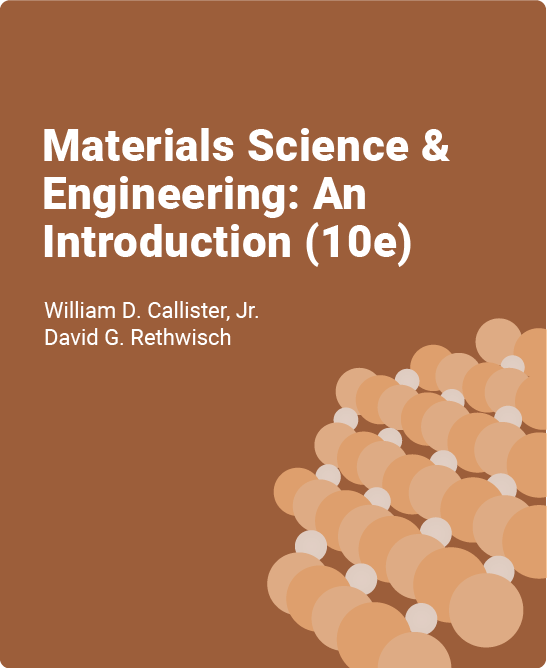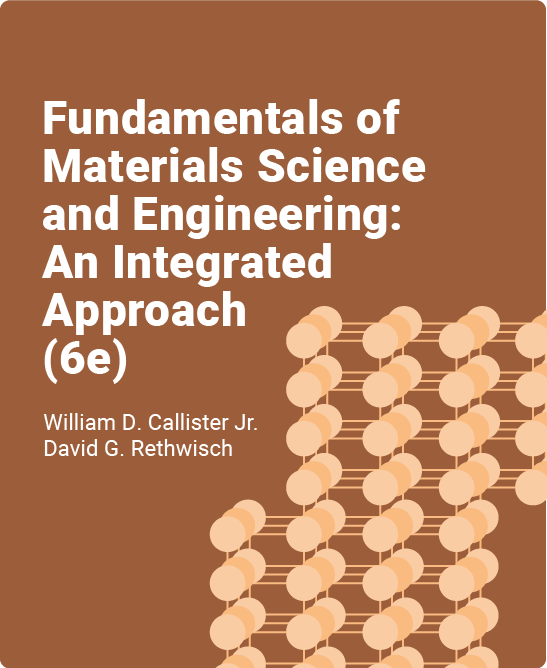Resources for Teaching Materials Science
Our October 2025, the zyBooks content team led a peer-to-peer Materials Science Workshop that explored two critical areas: addressing common student misconceptions and implementing collaborative learning strategies. The discussion highlighted how students often struggle with crystallography, phase diagrams, mechanical properties, and more—not because these concepts are inherently difficult, but because of specific, identifiable misconceptions.
The resources compiled here include research papers, hands-on demonstrations, targeted Callister problems, zyBook animations, and real-world videos. They’re organized to support instructors at different engagement levels, from quick implementations to larger changes to your course.
Whether you’re addressing a specific misconception or building collaborative learning experiences, these resources provide practical, research-backed tools you can use immediately in your materials science courses.
I. Addressing Misconceptions
A. Research related to misconceptions / concept inventories
- Krause, Stephen, J. Chris Decker, and Richard Griffin. “Using a materials concept inventory to assess conceptual gain in introductory materials engineering courses.” 33rd Annual Frontiers in Education, 2003. FIE 2003.. Vol. 1. IEEE, 2003.
https://ieeexplore.ieee.org/abstract/document/1263337
- Heckler, Andrew F., and Rebecca Rosenblatt. “Student difficulties with basic concepts in introductory materials science engineering.” 2011 Frontiers in Education Conference (FIE). IEEE, 2011.
https://ieeexplore.ieee.org/abstract/document/6142989
- Richardson, Jim. “Concept inventories: Tools for uncovering STEM students’ misconceptions.” Assessment and education research (2004): 19-26.
https://www.aaas.org/sites/default/files/02_AER_Richardson.pdf
B. Videos and images for addressing misconceptions
- Khan Academy: video on phase diagrams, aimed at chemistry students, but still applicable https://www.khanacademy.org/science/chemistry/states-of-matter-and-intermolecular-forces/states-of-matter/v/phase-diagrams
- Materials Sciences 101: Intro to Materials Science and Engineering videos – Dr. Taylor Sparks, University of Utah – https://youtube.com/playlist?list=PLL0SWcFqypCm4xCn64xO7RS62PPzy-oP8&si=10tCUY22zfYkOGGG
- Videos of how materials science is used in the real world:
- Biomedical / corrosion of dental implants https://www.youtube.com/watch?v=2gt9uLwYKY8&list=PLsLmmrdahd7MvST5iRBb44D-AWs0d-dT_&index=7
- How to create buildings that withstand earthquakes https://www.weforum.org/videos/how-to-create-buildings-that-withstand-earthquakes/
- Video on uniform corrosion with examples: https://www.youtube.com/watch?v=K87KvHPwiI
- Corrosion simulator tools: https://captaincorrosion.com/galvanic-corrosion-simulator/
- Collection of images of fractured materials – Dr. Jeff Thomas, Missouri Science & Technology – https://web.mst.edu/~jthomas/classe
- After the Workshop, Dr. Steve Krause sent a note to mention that he created these student tutorial videos made by Dr. Steve Krause, Arizona State University https://www.youtube.com/user/MaterialsConcepts
- From participant Troy Munro: TEC-Science also has a lot of good videos on youtube: https://www.youtube.com/@tec-science
C. zyBooks problems for addressing misconceptiosn
All of the end of chapter homework problems mentioned in this section are from Callister: Materials Science and Engineering: An Introduction, 10th edition and Callister: Fundamentals of Materials Science and Engineering, 6th edition. These problems are available in all Wiley formats – e-text, print, and the zyBook.
In the zyBook, all of the end of chapter problems are available, they are in a section in each chapter called Exercises and are not autograded. Selected end of chapter problems are also available as Challenge Activities, which are automatically graded and algorithmic (values change). zyBooks Challenge Activities include the original problem number in their name, for example:

Crystal Structures
Shape, characteristics, and features
Resources:
- Crystal Structures – 3D Models
- https://a.co/hMrSsOd
- https://www.indigoinstruments.com/molecular_models/unit/kits/fcc-crystal-structure-model-69511.html
- End of chapter homework problems
| Materials Science & Engineering: An Introduction, 10e | Fundamentals of Materials Science & Engineering, 6e | |
| Crystal Structures | ||
| Shape, characteristics, and features | ||
| Metallic Crystal Structures | 3.2, 3.12, Reserve 3.1 | 3.2, 3.12, Reserve 3.1 |
| Crystal Systems | Reserve 3.12-3.19 | Reserve 3.12-3.19 |
| Point Coordinates | 3.24, 3.25 | 3.46, 3.47 |
| Crystallographic directions | 3.37, 3.39 | 3.60, 3.62 |
| Crystallographic planes | 3.52, 3.54 | 3.76, 3.78 |
| Linear and planar densities | 3.57, 3.58 | 3.81, 3.82 |
Phase Diagrams
Solubility and solubility limit
Resources:
- End of chapter homework problems
| Materials Science & Engineering: An Introduction, 10e | Fundamentals of Materials Science & Engineering, 6e | |
| Solubility and solubility limit | 9.1, 9.2 | 10.1, 10.2 |
Electrical properties
Electrical conductivity of different materials
Resources:
- End of chapter homework problems
| Materials Science & Engineering: An Introduction, 10e | Fundamentals of Materials Science & Engineering, 6e | |
| Electrical conductivity of different materials | 18.1, 18.2, 18.3 | 12.1, 12.2, 12.3 |
Student conflation of similar concepts and terms
Conflation of Mechanical properties
Resources:
- End of chapter homework problems
| Materials Science & Engineering: An Introduction, 10e | Fundamentals of Materials Science & Engineering, 6e | |
| Conflation of Mechanical Properties | 6.3, 6.4, 6.6, 6.7, 6.10 | 7.3, 7.4, 7.6, 7.7, 7.10 |
Conflation of composition and phase fraction
Resources:
- End of chapter homework problems
| Materials Science & Engineering: An Introduction, 10e | Fundamentals of Materials Science & Engineering, 6e | |
| Conflation of composition and phase fraction | 9.13, 9.18, 9.20, 9.21 | 10.13, 10.18, 10.20, 10.21 |
Student diff with reasoning about multivariable concepts
Conflation of force and stress
Resources:
- End of chapter homework problems
| Materials Science & Engineering: An Introduction, 10e | Fundamentals of Materials Science & Engineering, 6e | |
| Conflation of force and stress | 6.3, 6.4, 6.6, 6.7, 6.10 | 7.3, 7.4, 7.6, 7.7, 7.10 |
Conflation of mass density with atomic separation
Resources:
- End of chapter homework problems
| Materials Science & Engineering: An Introduction, 10e | Fundamentals of Materials Science & Engineering, 6e | |
| Conflation of mass density with atomic separation | 3.7 – 3.11, 3.13 | 3.7 – 3.11, 3.14 |
Student use of inappropriate models or analogies
Stretched atomic bonds during plastic deformation
Resources:
- End of chapter homework problems
| Materials Science & Engineering: An Introduction, 10e | Fundamentals of Materials Science & Engineering, 6e | |
| Stretched atomic bonds during plastic deformation | 7.1, 7.4, 7.18 | 8.4 |
Incorrect cause of thermal expansion
Resources:
- End of chapter homework problems
| Materials Science & Engineering: An Introduction, 10e | Fundamentals of Materials Science & Engineering, 6e | |
| Incorrect cause of thermal expansion | 19.7, 19.13 | 17.7, 17.13 |
Student difficulties with graphs and diagrams
Stress-strain curve
Resources:
- End of chapter homework problems
| Materials Science & Engineering: An Introduction, 10e | Fundamentals of Materials Science & Engineering, 6e | |
| Stress-strain curve | 6.1 | 7.1 |
D. Additional zyBook resources
Below are the resources available in the zyBooks, in addition to the end of chapter problems. They include:
- Animations (as Participation Activities)
- Learning questions (as Participation Activities)
- VMSE
- Challenge Activities (autograded algorithmic problems)
Crystal Structures
Shape, characteristics, and features
Resources:
- Crystal Structures – 3D Models
- https://a.co/hMrSsOd
- https://www.indigoinstruments.com/molecular_models/unit/kits/fcc-crystal-structure-model-69511.html
- Animations and VMSE in Sections:
| Materials Science & Eng: An Introduction | Fundamentals of Materials Sci & Eng |
| 3.4, 3.7, 3.9, 3.10, 3.12 | 3.4, 3.11, 3.13, 3.14, 3.15 |
- Zy Challenge Activities:
Metallic Crystal Structures
| Materials Science & Eng: An Introduction | Fundamentals of Materials Sci & Eng |
| 3.4.1, 3.4.2, 3.4.3 | 3.4.1, 3.4.2, 3.4.3 |
Point coordinates
| Materials Science & Eng: An Introduction | Fundamentals of Materials Sci & Eng |
| 3.8.1, 3.8.2 | 3.12.1, 3.12.2 |
Crystallographic directions
| Materials Science & Eng: An Introduction | Fundamentals of Materials Sci & Eng |
| 3.9.2, 3.9.4 | 3.13.1, 3.13.2 |
Crystallographic planes
| Materials Science & Eng: An Introduction | Fundamentals of Materials Sci & Eng |
| 3.10.1, 3.10.3 | 3.14.1, 3.14.3 |
Linear and planar densities
| Materials Science & Eng: An Introduction | Fundamentals of Materials Sci & Eng |
| 3.11.1, 3.11.2 | 3.15.1, 3.15.2 |
Phase Diagrams
Solubility and solubility limit
Resources:
- Zy Animations:
| Materials Science & Eng: An Introduction | Fundamentals of Materials Sci & Eng |
| Animation 9.2.1 | Animation 10.2.1 |
- Zy Challenge Activities
| Materials Science & Eng: An Introduction | Fundamentals of Materials Sci & Eng |
| 9.2.1, 9.2.2 | 10.2.1, 10.2.2 |
Mechanisms of plastic deformation in metals
Dislocation motion
Resources:
- Animations in the zyBook
| Materials Science & Eng: An Introduction | Fundamentals of Materials Sci & Eng |
| Animation 7.8.1 | Animation 9.1.1 |
Electrical properties
Electrical conductivity of different materials
Resources:
- Animations in the zyBook
| Materials Science & Eng: An Introduction | Fundamentals of Materials Sci & Eng |
| Animation 18.6.1 | Animation 12.6.1 |
- Zy Challenge Activities
| Materials Science & Eng: An Introduction | Fundamentals of Materials Sci & Eng |
| 18.3.1, 18.3.2, 18.3.3 | 12.3.1, 12.3.2, 12.3.3 |
Student conflation of similar concepts and terms
Conflation of Mechanical properties
Resources:
- Sections in zyBooks (Animations, question sets, VMSE, etc.):
| Materials Science & Eng: An Introduction | Fundamentals of Materials Sci & Eng |
| Sections 6.2, 6.3, 6.6 | Sections 7.2, 7.3, 7.6 |
- Zy Challenge Activities
| Materials Science & Eng: An Introduction | Fundamentals of Materials Sci & Eng |
| 6.3.1, 6.3.2, 6.3.3, 6.3.4, 6.3.5 | 7.3.1, 7.3.2, 7.3.3, 7.3.4, 7.3.5 |
Conflation of energy and force in atomic bonds
Resources:
- Section in zyBooks (Animations, question sets, VMSE, etc.):
| Materials Science & Eng: An Introduction | Fundamentals of Materials Sci & Eng |
| Section 2.5 | 2.5 |
Conflation of composition and phase fraction
Resources:
- Sections in zyBooks (Animations, question sets, VMSE, etc.):
| Materials Science & Eng: An Introduction | Fundamentals of Materials Sci & Eng |
| 9.8 | 10.8 |
- zyBook Challenge Activities
| Materials Science & Eng: An Introduction | Fundamentals of Materials Sci & Eng |
| 9.8.1, 9.8.2, 9.8.3, 9.8.4, 9.8.5, 9.8.6 | 10.8.1, 10.8.2, 10.8.3, 10.8.4, 10.8.5, 10.8.6 |
Student diff with reasoning about multivariable concepts
Conflation of force and stress
Resources:
- Sections in zyBooks (Animations, question sets, VMSE, etc.):
| Materials Science & Eng: An Introduction | Fundamentals of Materials Sci & Eng |
| 6.2, 6.3 | 7.2, 7.3 |
- Zy Challenge Activities
| Materials Science & Eng: An Introduction | Fundamentals of Materials Sci & Eng |
| 6.3.1, 6.3.2, 6.3.3, 6.3.4, 6.3.5 | 7.3.1, 7.3.2, 7.3.3, 7.3.4, 7.3.5 |
Conflation of mass density with atomic separation
Resources:
- Section in zyBooks (Animations, question sets, VMSE, etc.):
| Materials Science & Eng: An Introduction | Fundamentals of Materials Sci & Eng |
| 3.5 | 3.5 |
- Zy Challenge Activities:
| Materials Science & Eng: An Introduction | Fundamentals of Materials Sci & Eng |
| 3.5.1, 3.5.2, 3.5.3, 3.5.4 | 3.5.1, 3.5.2, 3.5.3, 3.5.4 |
Student use of inappropriate models or analogies
Stretched atomic bonds during plastic deformation
Resources:
- Sections in zyBooks (Animations, question sets, VMSE, etc.):
| Materials Science & Eng: An Introduction | Fundamentals of Materials Sci & Eng |
| 7.2 – 7.7 | 8.3 – 8.9 |
Incorrect cause of thermal expansion
Resources:
- Section in zyBooks (Animations, question sets, VMSE, etc.):
| Materials Science & Eng: An Introduction | Fundamentals of Materials Sci & Eng |
| 19.3 | 17.3 |
- zyBook Challenge Activities
| Materials Science & Eng: An Introduction | Fundamentals of Materials Sci & Eng |
| 19.3.1, 19.3.2 | 17.3.1, 1 7.3.2 |
Student difficulties with graphs and diagrams
Stress-strain curve
Resources:
- Section in zyBooks (Animations, question sets, VMSE, etc.):
| Materials Science & Eng: An Introduction | Fundamentals of Materials Sci & Eng |
| 6.3 | 7.3 |
- zyBook Challenge Activities
| Materials Science & Eng: An Introduction | Fundamentals of Materials Sci & Eng |
| 6.3.5 | 7.3.5 |
II. Collaborative Learning
Research
Virtual Labs:
- Bourguet et al., “Virtual and Augmented Reality for Teaching
Materials Science: a Students as Partners and as Producers Project” 2020
https://ieeexplore.ieee.org/abstract/document/9368381
- Cherner, Yakov E., et al. “Implementation of interactive and adjustable cloud-based e-learning tools for 21st century engineering education: Challenges and prospects.” 2019 IEEE World Conference on Engineering Education (EDUNINE). IEEE, 2019.
https://ieeexplore.ieee.org/abstract/document/8875847
Collaborative Learning Exercises:
- Gleixner, Stacy, and Hilary Lackritz. “Use of collaborative learning exercises to increase student motivation and learning in an Introduction to materials engineering course.” 2004 Annual Conference. 2004.
Project-based Learning:
- Goodman, Sarah A., and Emily L. Atieh. “Campus Re-engineered: Tackling problems close to home to promote interest in the field of Materials Science and Engineering for non-majors.” 2024 ASEE Annual Conference & Exposition. 2024.
- Desouky, Osama, and Marwa AbdelGawad. “Engaging Undergraduate Students in Experimental Learning in Materials Science through a Hybrid Project-Based Learning.” 2024 ASEE Annual Conference & Exposition. 2024.
- Grunenfelder, Lessa Kay. “Introductory materials science: A project-based approach.” 2023 ASEE Annual Conference & Exposition. 2023.
https://peer.asee.org/introductory-materials-science-a-project-based-approach
In-class Demos:
- Corleto, Carlos R., et al. “Faculty-Led Videos of Real-World Industrial and Research Applications in a Materials Science Course.” 2023 ASEE Annual Conference & Exposition. 2023.
- Balawi, Shadi, and Matt Pharr. “Experiential Learning Utilizing Class and Lab Demos in a Material Science and Manufacturing Course.” 2024 ASEE-GSW. 2024.
zyBooks Research:
- Barlow, Ryan, et al. “Assessing the Effects of an Interactive Web-native Materials Science Textbook on Student Self-efficacy.” 2024 ASEE Annual Conference & Exposition. 2024.
- Gordon, Chelsea, et al. “Student Engagement with Interactive Engineering Textbook Reading Assignments When Tied to the Grade.” 2023 ASEE Annual Conference & Exposition. 2023.
- Welter, Jenny, et al. “Student Performance Improvement in a Circuit Analysis Course when Interactive Web-Native Textbook Activities are Assigned for Points.” 2025 ASEE Annual Conference & Exposition. 2025.
For more on zyBooks Research, go to: https://www.zybooks.com/research_tags/engineering-research/










